

Dietitians Dish – March 02, 2020
Keep working on making habits effortless!
Habit #3 – Pick 2 days a week to enjoy a serving of fish or seafood!
It’s easy to save time and money with frozen foods! Nothing goes to waste. Frozen foods are nutritious and affordable! Keep your freezer stocked with fish and seafood so you can make “fast food” that’s better than take-out.
Frozen seafood is as good as (or better than) fresh from the fish counter. Technology advances allow for flash freezing of seafood shortly after it is caught, locking in nutrients. This makes frozen fish and seafood a great option for high-quality, lean protein.
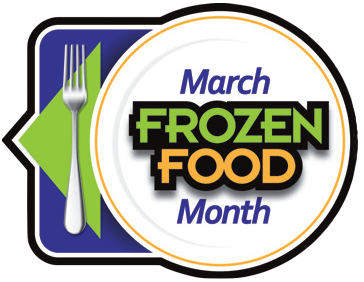
DINNERTIME DILEMMA – it’s STILL in the freezer!
How do you quickly thaw and maintain quality for frozen fish and seafood?
- COOK (from frozen) – Rinse under cold water to remove ice glaze, pat dry, then increase cook time (~50%)
- THAW – Submerge in cold tap water in leak-proof packaging
- DEFROST – Microwave on defrost in short intervals until it is pliable but still icy
Shrimp Fried Quinoa Bowl
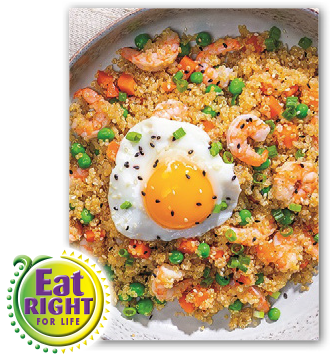
Ingredients:
- 3 cups cooked Full Circle organic quinoa
- 1 cup frozen peas & carrots
- 1 cup frozen, cooked
salad shrimp (thawed)
- 1 Tbsp. less-sodium soy sauce
- 1/2 tsp. garlic powder
- 1/4 tsp. salt
- 1/4 tsp. pepper
- 4 eggs
Directions:
- Cook 1 cup frozen peas and carrots in microwave oven as label directs.
- Heat large skillet over medium-high heat; spray with cooking spray. Add 1 cup thawed cooked salad shrimp and cooked quinoa; cook 3 minutes or until heated through, stirring occasionally.
- Add soy sauce, garlic powder, salt and pepper to skillet; cook 1 minute. Fold peas and carrots into skillet; cook 1 minute or until heated through, stirring occasionally.
- Heat large nonstick skillet over medium-high heat; spray with cooking spray. Add 4 large eggs to skillet; cook 3 minutes or to desired doneness.
- Divide quinoa mixture into 4 bowls; top with eggs and garnish with thinly sliced green onions and/or sesame seeds, if desired.


Dietitians Dish – February 24, 2020
Keep working on making habits effortless!
Habit #3 – Pick 2 days a week to enjoy a serving of fish or seafood!
You may have heard the recommendation for eating 2 servings of fish or seafood per week. But do you know about the research findings backing that up?
- Reduced death from all health conditions
- Increased lifespan in older adults
- Lower incidence of depression
- Higher IQ in children whose mothers ate seafood while pregnant
Many health organizations suggest getting at least 250-500 mgs of Omega-3 fatty acids (EPA+DHA) per day. The American Heart Association (AHA) recommends 1,000 mgs per day for people with coronary heart disease and two meals of oily fish per week for people without.
Maple Mustard Salmon
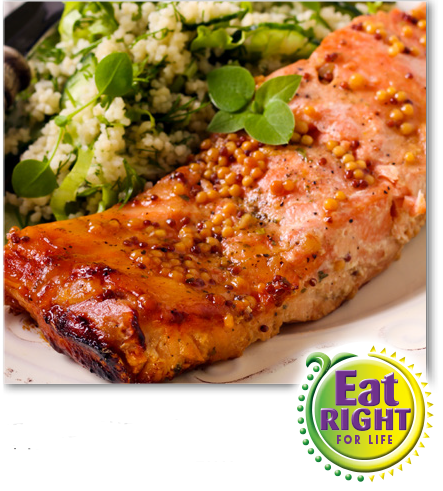
Ingredients:
- 1 1/2 – 2 lbs. salmon
- 1/2 cup Full Circle maple syrup
- 1/3 cup honey whole grain mustard
- 1/3 tsp. salt
Directions:
- Preheat oven to 375° F.
- Place salmon on a large baking sheet. In a small bowl, mix together salt, syrup, and mustard. Brush with the mustard mixture to coat the top of the salmon.
- Bake for 12-15 minutes, or until fish is cooked to your liking.
- Optional: Serve with roasted vegetables and seasoned brown rice.
Recipe adapted from Seafood Nutrition Partnership


Dietitians Dish – February 17, 2020
Keep working on making habits effortless!
Habit #2 – Drink 8-ounces of a calorie-free beverage before you eat.
Getting the right amount of hydration is important, especially for athletes and anyone who is physically active. Commercial sports drinks were developed for high-intensity college athletes. Many contain electrolytes (sodium and potassium) and sugar to replenish the body, in levels that are higher than what exercisers and child athletes require.
So, who should consume sports drinks? People of any age undergoing an intense exercise level lasting more than 1 hour. Hydrating at the right times is very important, and with the best beverage for your activity level.
- Continue to drink a cup of water or calorie-free beverage before a meal (Habit #2)
- Drink water a couple hours before you begin physical activity
- Drink water while you are being active
- Drink infused water or chocolate milk after to help promote recovery.
The activity and sweat losses make it important to replenish fluid, carbohydrates, protein and electrolytes. Low potassium may lead to muscle cramping. Some fruits and vegetables which are high in potassium are: bananas, oranges, cantaloupe, honeydew, dried fruits, potatoes, cucumbers, mushrooms and leafy greens.
Try this veggie-infused water as a post-exercise beverage or as another flavorful option before a meal.
Green Water
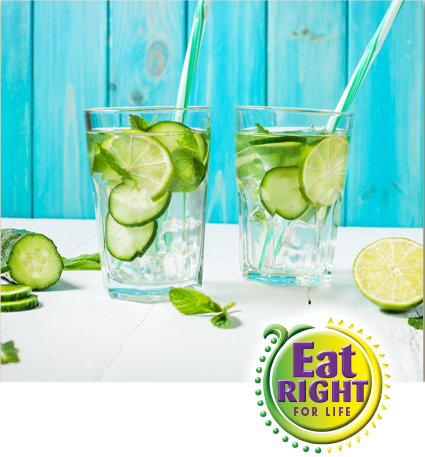
Ingredients:
- 1 1/2 celery hearts
- 1/3 sliced seedless cucumber
- Small handful of fresh parsley leaves
- 3 mint leaves
- 1/2 sliced lime
- 1 gallon of water
Directions:
- Wash all of your ingredients thoroughly before placing in a beverage container.
- Fill the container with 1 gallon of water and refrigerate.
- Allow water to infuse at least 30 minutes before serving. Infusing overnight will create a stronger flavor. Remove the vegetables within 24 hours. The water will keep for up to a week in refrigeration.


Dietitians Dish – February 10, 2020
Keep working on making habits effortless!
Habit #2 – Drink 8-ounces of a calorie-free beverage before you eat.
Drinking enough water to stay properly hydrated benefits the body, but water is not the only option. Swap your pre-meal glass of water with a green tea-based drink to keep your taste buds happy! Calorie-free options, like brewed tea, have even more health benefits than water alone.
Green tea is a source of fluoride, a mineral that strengthens teeth. Tea is also a natural source of manganese, an essential mineral needed for bone formation, which plays a role in energy metabolism. Flavonoids are also typically found in tea, and help to maintain normal blood vessel function.
Brew a cup or pitcher of green tea and drink it hot or iced. Vary the flavors with the addition of natural sweeteners and/or some fresh fruit combinations.
The addition of red berries would make a lovely Valentine’s beverage!
Iced Green Tea
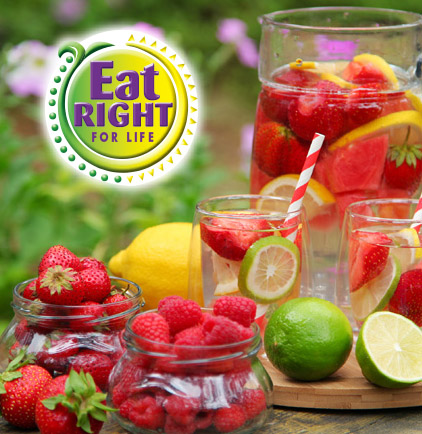
Ingredients:
- 4 cups water
- 4 green tea bags
- 6 cups of ice cubes
- Sweetener (optional)
- Fruit, slices or chunks (optional)
Directions:
- Boil the water, turn off and let stand a few minutes so temperature drops slightly.
- Add tea bags to a pitcher and pour boiled water over them, allowing them to submerge and steep for 3-5 minutes.
- Remove tea bags, add sweetener and/or fruit (if desired).
- Stir in 6 cups of ice cubes (or 4 cups of cold water).
- For a natural sweetener, thoroughly mix 2 Tablespoons of honey with a 1/2 cup of hot water until dissolved into a syrup. Use by the teaspoon until reaching desired sweetness.


Dietitians Dish – February 03, 2020
Keep working on making habits effortless!
Habit #2 – Drink 8-ounces of a calorie-free beverage before you eat.
Over HALF of the human body is water!
This means, whether you’re getting enough affects your whole body. From your skin and brain to the processes of vital organs, water is needed each day to perform normal functions and keep you healthy. When you are dehydrated, your body isn’t running as efficiently as it should, which in turn triggers you to crave water.
Is your body sending signals?
It’s often difficult for the body to decipher between hunger and thirst. Use this simple rule of thumb: if you feel like you are hungry, first try drinking a glass of water. Your body may be giving you first signs of dehydration.
Can you achieve your daily fluid needs other than drinking water?
Absolutely! Try juicy foods such as cucumbers, tomatoes, and peaches. Some foods perceived as “dry” also contain high percentages of water… include beans, roasted chicken and baked salmon in your diet. Fluids still need to be a top priority. If you are bored with water, try herbal tea, sparkling water, or water with fruit flavors.
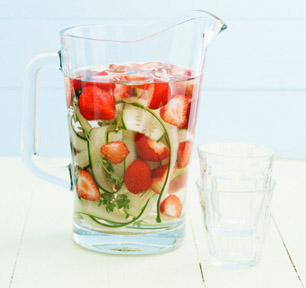
Flavored Ice Cubes
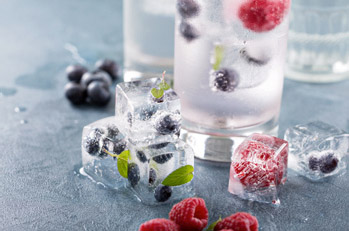
Ingredient Combinations:
- Lemon + Lime
- Watermelon + Basil
- Strawberry + Basil
- Cucumber + Mint
- Mint + Lime
- Blackberry + Mint
- Grapefruit + Rosemary
- Apple + Pear
- Lavender + Mint
- Blueberry + Raspberry
- Mango + Pineapple
- Grape + Cherry
- Orange + Pineapple
- Blueberry + Lemon
Directions:
- Prepare your ingredients. Wash fruit and herbs and chop to your desired size.
- Place a few pieces of fruit and/or herbs into each compartment of your ice cube tray.
- Fill the ice cube tray up with water and freeze.
Adapted from Have a Plant (fruitsanveggies.org).



